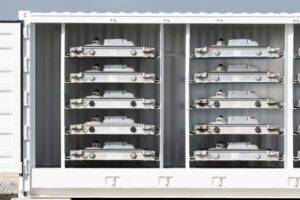With the pressing challenges of escalating energy consumption, climate change, and diminishing fossil fuel reserves, there’s an unequivocal call for revolutionary solutions to steer our future toward sustainability.
Enter the innovative Lithium Iron Phosphate (LFP) battery—. which represents a significant technological leap in energy storage, LFP batteries are not merely products of human ingenuity; they are symbols of our unwavering commitment to curbing carbon footprints and championing eco-friendly alternatives.
At the heart of this shift is ICL Group, (NYSE: ICL) a global powerhouse in specialty minerals, dedicated to sculpting sustainable solutions that stand as pillars in the realms of energy storage, renewable energy, and oil and gas drilling, among others. Their endeavors are setting the stage for an energy renaissance, painting a vision of a future where technology and nature harmoniously coexist.
Investing $400 million, ICL is in the midst of constructing an avant-garde LFP battery materials production site in St. Louis, Missouri. This facility, boosted by a generous $197 million grant from the U.S. Department of Energy, aims to annually produce a staggering 30,000 metric tons of LFP by 2025.
LFP Batteries: The Nexus of Innovation and Sustainability
LFP batteries aren’t just the talk in energy circles; they signify a revolutionary change. Their unique composition using lithium iron phosphate as their cathode, complemented by a graphite anode, facilitates efficient energy, that positions them years ahead of their counterparts.
A Fusion of Power and Safety
The LFP design is ingenious. By incorporating lithium iron phosphate as the cathode material, these batteries deliver robust power while reducing risks often associated with other lithium-ion cells—namely, thermal runaways or fires. This means that even in the most demanding of situations, LFP batteries’ inherent stability drastically reduces risks associated with thermal runaways. In addition, their robust nature ensures deeper discharges, translating to prolonged life cycles and consistent performance.
Championing Eco-Friendly Materials
The environmental benefits of LFP batteries are twofold. First, they utilize iron—a resource that’s abundant, reducing our dependency on materials like cobalt or nickel, which come with ecological concerns. Secondly, their longer lifespan translates to reduced waste, contributing to a circular economy where resources are used to their fullest potential before recycling.
Versatility Redefined
From the smart devices we hold in our hands to the electric vehicles we drive with their large energy storage units we rely on, LFP batteries adapt seamlessly. Their cost-effective nature, combined with their sourced-from-abundant materials profile, provides excellent returns on investment.
Economically Forward-thinking
While upfront costs of any new technology can often be intimidating, LFP batteries are rewriting this narrative. Their longer life cycles, reduced maintenance, and enhanced safety features ensure that the total cost of ownership is competitive. As demand increases and production scales up, there’s a vision of these batteries becoming even more financially accessible, propelling them to be frontrunners in the energy storage domain.
Eco-friendliness
Predominantly using environmentally-conscious iron, LFP batteries shun the ethical and environmental concerns tied to cobalt or nickel-based batteries. Considering these, it’s no surprise that expert analysis projects the global demand for LFP batteries to soar, potentially pushing the market value beyond $40 billion by 2031.
A Monumental Step in St. Louis
St. Louis, Missouri, is now home to a significant stride in LFP production. ICL Group’s enterprise there heralds a bright future. The establishment not only anchors ICL Group’s ambition in the global battery materials landscape but also signifies a broader national shift towards green energy and sustainability.
This undertaking is part of a vast tapestry of green initiatives across the U.S. From the massive solar thermal power plant in California, powering over 200,000 homes, to the tidal energy experiments in Maine and sprawling wind farms in Texas, the U.S. is experiencing a green renaissance.
Global Synergy in Energy
Diverse parts of the world are becoming interconnected canvases where companies such as the ICL Group, Panasonic, Siemens, and BYD, driven by shared visions, are pushing boundaries to sculpt a sustainable future.
1. St. Louis’ ICL Initiative
Serving as a hallmark of sustainable transitions, the ICL initiative in St. Louis captures the essence of modern energy endeavors. It’s not just about the mammoth infrastructures or groundbreaking technologies. It’s about a commitment, deep-rooted in the heart of the Midwest, to reimagine how we harness, store, and utilize energy.
2. Panasonic’s Urban Energy Solutions
Panasonic (NYSE: PC), a titan in electronics, has been channeling its expertise into pioneering urban energy solutions. Their ‘Smart City’ projects are not just about making cities more technologically advanced but ensuring that these advancements lean on sustainable energy. By merging intuitive designs with efficient energy practices, Panasonic illustrates that the future of urban living is both smart and green.
3. Siemens: Pioneering Smart Energy Solutions
From its early days in 19th-century Germany, Siemens (SIEGY:OTC US) has been at the forefront of energy innovation. Today, their commitment to ‘smart’ energy solutions shines brightly. By prioritizing decentralized energy systems, Siemens empowers both bustling cities and remote communities, ensuring efficient and optimal energy utilization. Their blend of technology and dedication underscores a vision of an abundant, sustainable energy future, showcasing what’s achievable when human ingenuity meets purpose.
4. BYD’s Electric Revolution
Chinese conglomerate BYD, once known primarily for its rechargeable batteries, has made significant waves in the global EV market. But their ambition doesn’t stop there. BYD envisions an integrated green ecosystem, from solar farms to energy storage systems and electrified public transport. Their holistic approach showcases the potential of integrating varied energy solutions, reminding us that innovation is as much about breadth as it is about depth.
Concluding Remarks
Our planet is at a crucial juncture. The mounting pressures of climate change make the shift to sustainable energy solutions more than a desire—it’s a necessity. ICL Group, alongside companies like Panasonic, Siemens, and BYD are carving out the roadmap for this future. They remind us that while the journey toward sustainable energy is complex, the unified pursuit makes the destination attainable.
Embracing technologies like LFP batteries is more than just about energy; it’s about charting a course for a sustainable, prosperous future, where renewables are the backbone of our global energy narrative.
Read more:
LFP Batteries and the Revolution in Energy Storage














